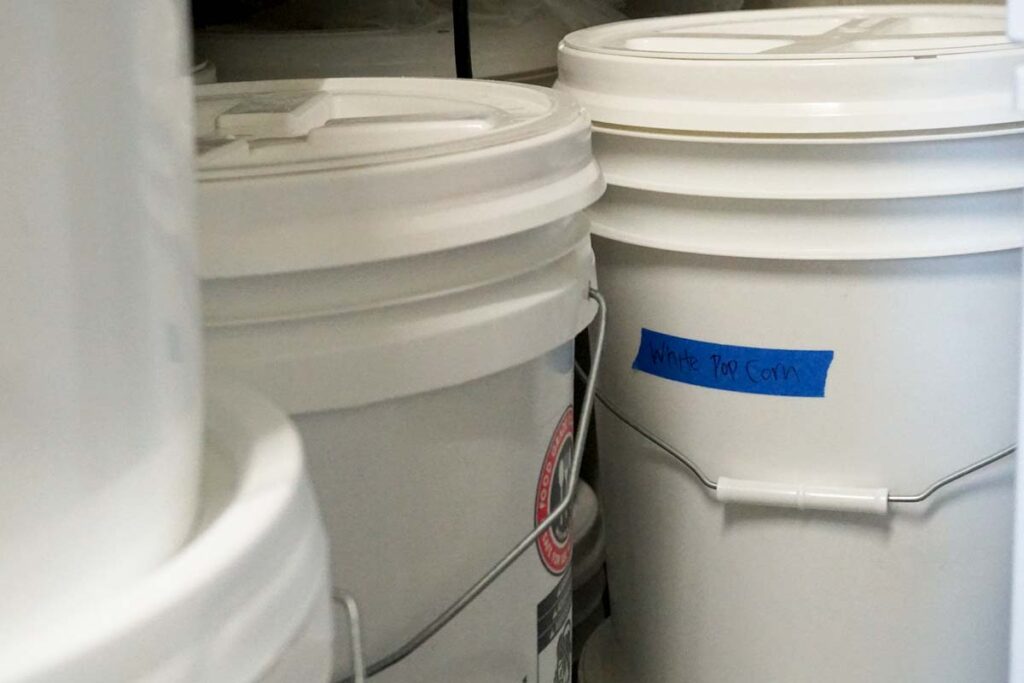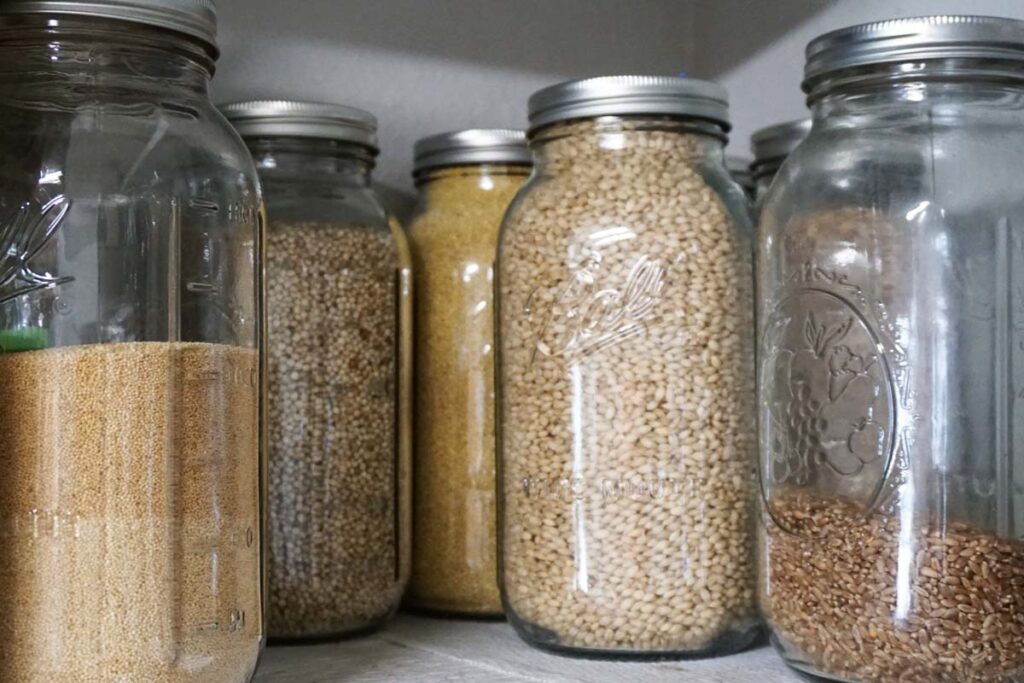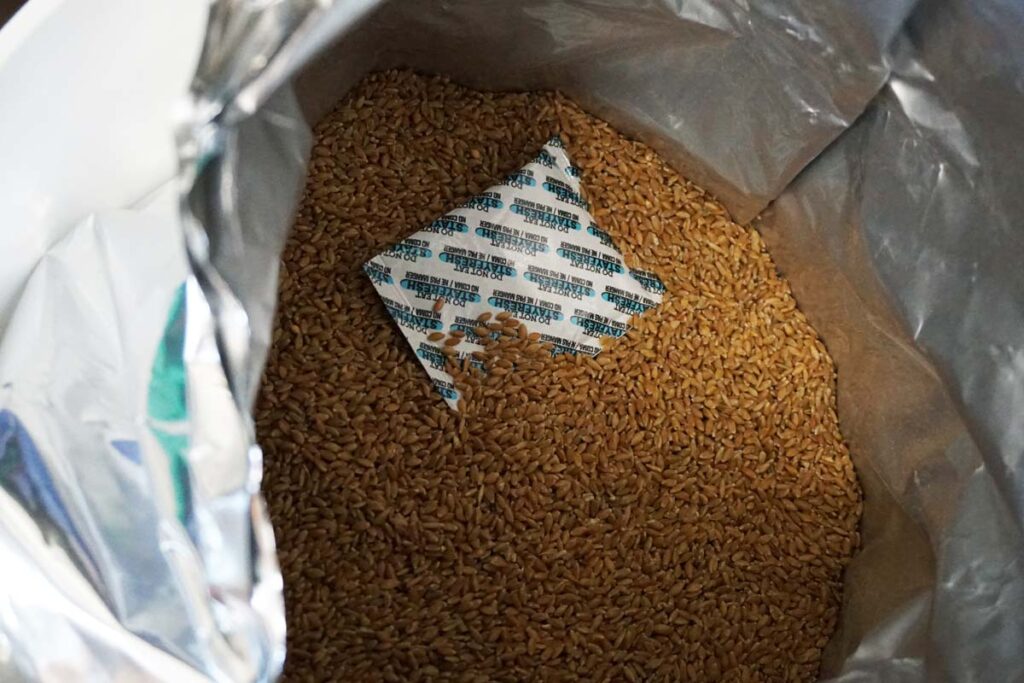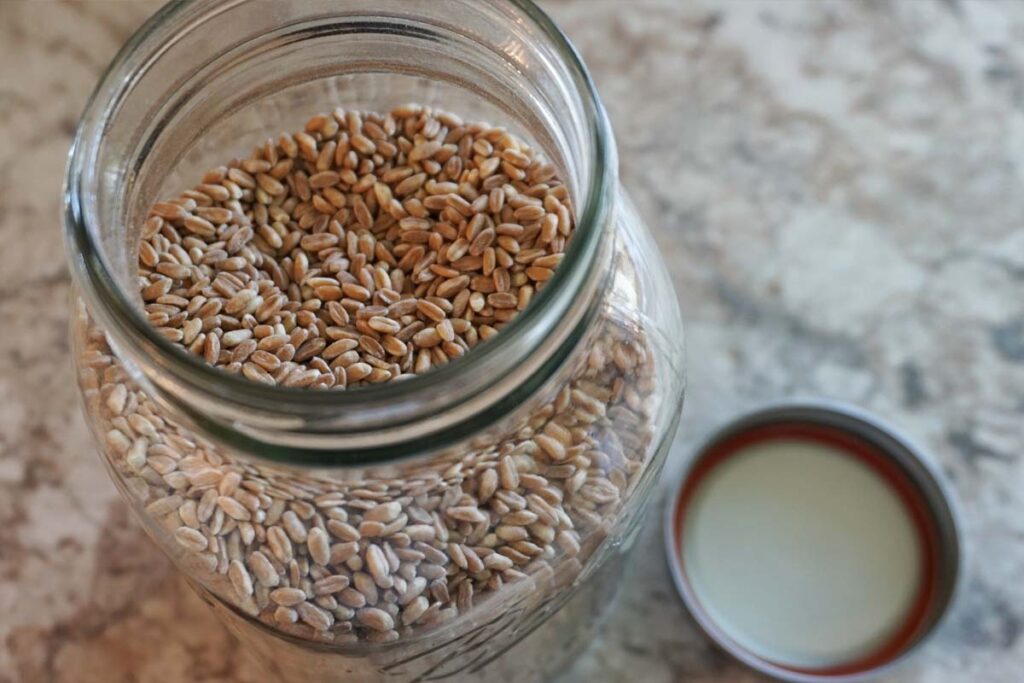Whole wheat berries are a fantastic and nutritious addition to my pantry, but properly storing them is essential to maintain their quality and freshness.
If you’re also wondering how to store whole wheat berries, as well as pseudo-grain seeds, I’ve compiled some tips to help you avoid some of the pitfalls I’ve gone through (including my 1-year battle with pantry moths).
Check out our entire storing grains at home series!
Storing is a critical part of baking and cooking. Without proper storage, grains can easily be lost to rodents, bugs, or they can go rancid, ruining your investment.
This is one-part of a three-part series on proper storage:
- How to store flour: Milled whole grains transform into flour, allowing us to create amazing food, but how we store them is important! I share my tips on how to keep your flour, from all-purpose to tricky rye, fresh, accessible, and ready-to-use.
- How to store whole grains (this article)
- Creating a working pantry system for flour and whole grains: I share the details of how I rotate through and store my grains to ensure I keep them safe and prevent them from going rancid
Importance of proper storage
Storing wheat berries properly is crucial for preserving their shelf life, food value, and freshness. When kept in ideal conditions, these nutritious grains can not only last for an extended period and retain their essential nutrients, they can last indefinitely–which is amazing!
Three big reasons to prioritize proper storage of your whole grains:
- Maintain their nutritional value. Whole grains are packed with protein, vitamins, and other nutrients that can be compromised if exposed to unfavorable conditions. To make the most of their health benefits, it’s important to store them correctly
- Maximize their shelf life. These versatile grains have a longer shelf life than processed flour, allowing me to keep them on hand for a variety of dishes without worrying about spoilage. Proper storage ensures that they stay fresh and usable indefinitely
- Protect your investment as they are expensive. Whole grains are NOT cheap. In many ways it’s more cost-effective to buy whole grains than pre-milled flours from the grocery store, but a 50-pound bag or bucket can easily exceed $100. I want to ensure proper storage and avoid having to throw out costly food
Key considerations when storing whole grains
There are five things your whole grains hate, and that’s heat, moisture, light, pests, and spoilage. Keeping your grains away from these five things can keep them dry, cool, and happy for years to come.
Heat
I try to always store my wheat berries in a location with a consistent temperature, ideally between 50-70°F (10-21°C). Keeping the wheat berries cool helps to prevent any potential growth of bacteria or mold, and a stable temperature prevents fluctuations that can lead to spoilage.
This means here in Texas I have to keep them in a climate-controlled environment … which is hard because grains can take up a lot of space. Over time I have decided to also use the area in my garage that shares a wall with the house as a storage spot. Its proximity to my climate-controlled house helps it stays fairly consistent, even though it gets up to about 80°F. So, do the best you can!
Moisture
Moisture is another crucial element to be mindful of when storing wheat berries. If there is too much moisture in the air, this can lead to mold or bacteria growth, spoiling the grains. Especially if you live in a high-moisture climate, you need to make sure you not only store grains away from rain or possible flooding (like in a basement), but also moisture in the air.
I store my wheat berries in a dry location (our pantry or garage) with low humidity levels (by using oxygen absorbers in mylar bags).
Light
Light is another factor to consider. Exposure to sunlight or artificial light can cause the wheat berries to degrade over time. This isn’t a concern for whole grains in food-grade buckets, but the grains I keep in clear mason jars are kept in my pantry, away from any direct sources of light.
Pests
To protect against insects and oxidation, make sure to always use an airtight container. This will not only prevent any pests from getting to the grains but also minimize oxygen exposure, which can cause whole grains to spoil faster.
Spoilage
The above considerations are to avoid spoilage, but something not talked about is keeping your whole grains away from things that can spoil them. Think of it this way: non-spoiled grains should be kept away from spoiled grains.
I do this by not only storing grains separately from other types of grains, but different batches together. I don’t combine one bag of rye with another as it prevents cross-contamination.
Choosing containers for storage
The right choice of container can make a significant difference in the longevity and freshness of your grains. In my experience, there are only three options to preserve the quality of whole wheat berries.
1. Food-grade buckets

These are an excellent choice for storing large quantities of wheat berries, which I typically purchase in bulk. I prefer using 5-gallon (or 3.5-gallon) plastic buckets with airtight gamma lids because they provide a secure seal and make accessing the wheat berries simple. These food-safe containers ensure that the grains are protected from moisture, pests, and other contaminants.
They also make it easy to stack and move around your grains. You can safely stack food-grade buckets 3 high, they are easy to label, and gamma lids make them easy to open and close. They are also reusable so once you make an investment in them, they are with you for life.
Recommended buckets: I have purchased my food-grade buckets from both Tractor Supply and Azure Standard. I’ve always been able to get gamma lids at my local Tractor Supply as well.
2. Glass jars

Another great option for storing wheat berries are glass containers, like mason jars. While they may not be as practical for large quantities, I find that they work well for smaller amounts that I plan to use in the near future. Additionally, mason jars allow me to see the contents clearly, making it easier to monitor how much wheat berries I have left.
Recommended jars: I use both these 1-gallon jars from Amazon (affiliate link) as well as 1/2-gallon mason jars, which you can get on Amazon (affiliate link) but I usually just pick them up at my local Walmart because they are significantly cheaper there.
3. Mylar bags

Mylar bags, first invented in the 1950’s, are silver in color and are known for their strength, temperature resistance, chemical stability, and their protection against gases, odors, and light. Mylar is the number one choice for long-term food storage because of all these reasons.
If you buy your grains in bulk like I do, they come in large paper bags, which are easy for moisture and pests to get through. When combined with oxygen absorbers, mylar protects your grains
Recommended bags: We’ve had good luck with this brand on Amazon, which we have bought both the 1-gallon mylar bags and 5-gallon mylar bags (affiliate links). We also have had good luck with these oxygen absorbers on Amazon (affiliate link).
4. Vacuum-sealed bags
Another way to store grains is with vacuum-sealed bags or #10 cans. Vacuum-sealed bags remove the air around the wheat berries, helping to preserve their freshness and #10 cans are also a popular option for long-term food storage since they are made of metal, which can provide a strong barrier against moisture and pests.
Recommended vacuum sealer: I would love to one day own a commercial vacuum-sealing machine, but right now we use this one from Walmart and it works great. I have not personally stored #10 cans of grains, but have purchased some already canned and am happy with the results.
5. Freezing
Freezing wheat berries is another way to preserve their quality. When storing wheat berries in the freezer, I make sure to spread them in a single layer on a baking sheet, freeze them for one to two hours, then transfer them to a freezer-safe container such as a Ziplock bag.
Additional tips for preserving wheat berries
Storing your whole wheat berries is so important! Here are some extra tips to help you properly store wheat berries and other whole grains like corn, oats, rye, millet, quinoa, and spelt:
- Always use airtight containers when storing wheat berries or any other grains. Airtight containers are crucial to keep out moisture and air, which can degrade the quality of grains over time
- Upgrade your food-grade bucket to use gamma seal lids. These lids provide an extra layer of protection, ensuring your wheat berries and other grains stay fresh and protected from external factors. It also makes opening and closing the bucket simple, even for kids
- Do the best you can to prioritize cool, dark places. This can be a pantry or even in a kitchen cabinet – just make sure it’s away from direct sunlight or heat sources.
- Sprinkle diatomaceous earth (DE) or natural repellents like peppermint, lavender oil, or bay leaves around the base of your food-grade buckets. A small amount of DE sprinkled in the storage container helps keep bugs away without the use of chemicals. DE has sharp edges that specifically target crawling pests, without posing any harm to humans or pets
- Keep it clean. Every month or so I’ll use the small nozzle on my vacuum cleaner and make sure I get around my jars of grains and flours, as well as my food-grade buckets. Keeping the area clean and free of crumbs or spills helps avoid attracting unwanted pests
- Rotate your grains. Creating a “working pantry” allows for you to establish a system, making sure you’re using the oldest grains first. I write more about that in the third part of this series here.
Frequently asked questions
How do you store wheat berries at home?
I usually store wheat berries in a cool, dry, and dark place, such as a pantry. Any airtight containers will work, so it just depends on how many whole grains you need to store and how often you’ll be accessing them. For smaller amounts use a 1/2 or 1-gallon jar or for larger amounts use a 3.5 or 5-gallon food-grade bucket with a gamma lid. Vacuum-sealed bags, ziplock bags, or even Tupperware-like containers can work as well.
What is the shelf life of whole wheat berries?
The shelf life of whole wheat berries depends on the storage conditions. When saved in airtight containers and stored properly in a cool, dry location, they can remain fresh indefinitely. Here is our handy reference chart on how long you can store different whole grains.
How do you store whole grains long-term?
For long-term storage, I use a large, 5-gallon mylar bag and fill it with my whole grains. I add an oxygen absorber before sealing the container with an iron for hair straightener. I then put the sealed mylar bag in a 5-gallon food-grade bucket with a gamma lid, and then label the food-grade bucket using painters tape.
How can I protect wheat berries from insects?
To protect wheat berries from insects, it’s essential to use airtight containers and maintain proper storage conditions (cool, dry, and dark). Another method is to freeze the wheat berries for at least 48 hours before storing, which kills any potential pests. Also, using an oxygen absorber in the storage container can help by creating an inhospitable environment for insects.
How long do wheat berries last in mylar bags?
When properly stored in mylar bags, wheat berries can last indefinitely. Mylar bags provide an effective barrier against moisture, air, and light, which helps to preserve the quality and freshness of the wheat berries over time. Add an oxygen absorber in the mylar bag to ensure it doesn’t spoil.
What are some tips for storing grains long term at home?
Here are some tips I’ve picked up for storing grains long term at home:
- Use airtight containers like food-grade buckets, mylar bags, or vacuum-sealed bags
- Store the grains in a cool, dry, and dark place, like a pantry
- Label the containers with the type of grain and the date it was stored. Use the oldest first
- Include oxygen absorbers in the sealed container to protect the grains from oxygen and pests (remember, oxygen absorbers don’t work if you are opening and closing the container, so I only use them with mylar bags or vacuum-sealed bags)
- Rotate the stored grains, using older grains first and replacing them with fresh ones as necessary
- Regularly check the storage area and containers for signs of moisture or pests, and address any issues promptly








